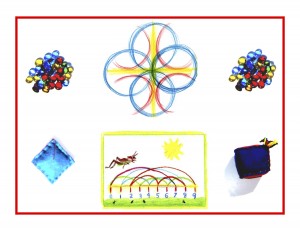Day 101
For one year, 365 days, this blog will address the Common Core Standards from the perspective of creating an alternate, ambient learning environment for math. Ambient is defined as “existing or present on all sides, an all-encompassing atmosphere.” And ambient music is defined as: “Quiet and relaxing with melodies that repeat many times.”
Why ambient? A math teaching style that’s whole and all encompassing, with themes that repeat many times through the years, is most likely to be effective and successful. Today’s post will continue with the Common Core Standards for Grade 1, listed in blue and followed by their ambient counterparts.
But first, I just need to say at 101 days I am a bit blog-weary. So today’s and tomorrow’s posts will be brief. (It does help that these two standards are quite straightforward and simple.) Next, on to the briar patch of place value. All the more so because both Waldorf and Math By Hand do not teach place value directly until Grade 2. But it may be possible to lay the foundation with age-appropriate lessons and activities, we’ll see. On to #7.
Operations and Algebraic Thinking 1.OA
Add and subtract within 20.
7. Understand the meaning of the equal sign, and determine if equations involving addition and subtraction are true or false. For example, which of the following equations are true and which are false? 6 = 6, 7 = 8 – 1, 5 + 2 = 2 + 5, 4 + 1 = 5 + 2.
This sort of activity is best not done on paper at first. Worksheets are not appropriate either. And you may want to substitute “is” for “equals” at this stage, since it’s more direct. Here are a few ambient, alternative suggestions:
Using a play clay equal sign, glass gems or other manipulatives, and the 4 processes color-coded strips, set up equations like those above and ask if they’re correct. Allowing enough time for counting and exploration to discover the answer, have your child use special markers to say yes or no. For example, shells = yes, small stones = no. After checking the markers, change those that need to be changed, while reviewing them. Then say that all the stones need to be changed to shells, providing guidance where needed. As always, making the abstract concrete is key.
Using a beanbag or a soft ball, play a game of math catch while saying the equations. As the child catches the ball, s/he says yes or no, providing the correct equations where needed. If you say “6 is 6” the child says yes as s/he catches the ball. If you say “5 + 2 is 8” the child says no as s/he catches the ball and says ” 5 + 2 is 7″ as s/he tosses it back to you. Be slow and deliberate with this, and bring it sparingly because of the child’s deep respect for you as the teacher to always tell the truth. Time enough for critical thinking later on!
Knowledge ensues in an environment dedicated to imaginative, creative knowing, where student and teacher alike surrender to the ensuing of that knowledge as a worthy goal. More on the Common Core Grade 1 Operations and Algebraic Thinking Standards along with their ambient counterparts tomorrow!












